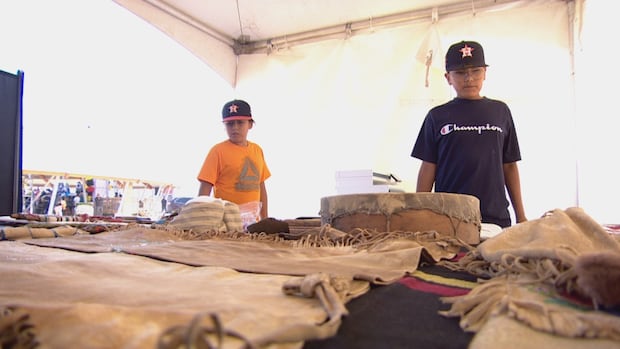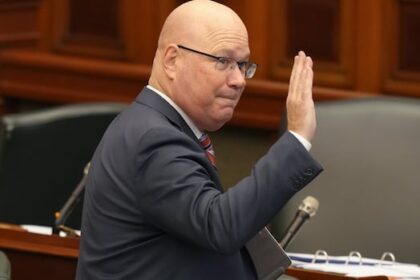IndigenousOn Sept. 9, Piapot First Nation celebrated not only the 150th anniversary of Chief Piapot’s signing of Treaty 4, but also the return of items belonging to him to the community.19 items include leggings, moccasins and pipesLouise BigEagle · CBC News · Posted: Sep 11, 2025 2:23 PM EDT | Last Updated: 1 hour agoThe repatriated items were on display at Piapot First Nation’s celebration of the 150th anniversary of Chief Piapot’s signing of Treaty 4 on Sept. 9. (Will Draper/CBC)On Sept. 9, Piapot First Nation in Saskatchewan celebrated not only the 150th anniversary of Chief Piapot’s signing of Treaty 4, but also the return of items belonging to him to the community.The 19 items, previously held by the Manitoba Museum in Winnipeg, included four pipes, a beaded shirt, moccasins, a beaded belt and an eagle fan. Most have not been used since 1898.”They’re not artifacts,” said Piapot Chief Mark Fox.”They’re still ceremonial belongings that we continue to use today, and it will continue to guide our nation not only from today, but 100 years from now.”Fox said they now have Piapot’s leggings with drawings telling “one of the stories of when he went into a great battle and there was a victory and so I’ve been pretty emotional.”The Manitoba Museum in Winnipeg returned the items at the request of the community. (Louise BigEagle/CBC)Fox said the community, the museum and KNT IRS Consulting all worked hard to get the items returned to his nation, his home and to his people last month. The community, about 20 kilometres northeast of Regina, got a chance to view the items for the first time this week at an event celebrating 150 years since signing onto Treaty 4.”Everything that’s here is going to benefit our people, carry our people, make us stronger and to continue to work hard and try for our people for a better life,” said Fox.The items will be protected and kept in cases, said Fox, in their medicine room in the community until they get a heritage centre up and running, so anyone from the community can go see them and sit with them for a while to pray and meditate.Rebuilding relationshipsManitoba Museum CEO Dorota Blumczyńska said the repatriation was community-led, through the museum’s repatriation policy.The items included gifts that Piapot gave to the minister who led his daughter’s wedding ceremony. The museum didn’t know the exact date when the items were acquired, as some items were donated to collections at previous museums that later went to the Manitoba Museum.In a news release, the museum said it recognizes repatriation as an important institutional responsibility that is more than returning objects but “is in support of Indigenous self-identity, spirituality and ceremony, languages, art, sovereignty, laws and governance.””We … understand the role of museums in harms of the past and the role of museums in housing the belongings of nations, some of which were acquired under duress, economic strain or under pressure,” said Blumczyńska.The community used the pipes in a special ceremony to honour the belongings coming back home. (Will Draper/CBC)There will be more repatriations as more communities learn about the process, Blumczyńska said.Blumczyńska and other museum staff traveled from Winnipeg to attend the Treaty 4 anniversary celebration earlier this week, where the items were on display for people to learn more about Chief Piapot.”I felt the sense of hope that was healing, pride, and reconnection,” said Blumczyńska.”It was very powerful and I was just grateful to bear witness to something so incredible.”Murray Ironchild is a knowledge keeper in Piapot First Nation. (Louise BigEagle/CBC)Knowledge keeper Murray Ironchild said they held a special ceremony for the items in the morning before the celebration, starting with a smoke of Piapot’s old pipe and singing with the drum.”We still sing some of Chief Piapot’s songs and are used for special ceremonies like a rain dance,” said Ironchild.”The way he came and did it, we still do it exactly the same way today, we haven’t changed anything.”Ironchild said Piapot was a man you couldn’t play around with and he made a lot of sacrifices for his people in hopes he was doing the right thing when signing Treaty 4.Ironchild said he hopes one day they can find exactly where his home was in the community but for now he is happy to have Piapot’s items home.ABOUT THE AUTHORLouise is a journalist with CBC Saskatchewan since September 2022. She is Nakota/Cree from Ocean Man First Nations. She holds a bachelor of fine arts from the University of Regina.
Monday, 22 Dec 2025
Canada – The Illusion
Search
Have an existing account?
Sign In
© 2022 Foxiz News Network. Ruby Design Company. All Rights Reserved.
You May also Like
- More News:
- history
- Standing Bear Network
- John Gonzalez
- ᐊᔭᐦᑊ ayahp — It happened
- Creation
- Beneath the Water
- Olympic gold medal
- Jim Thorpe
- type O blood
- the bringer of life
- Raven
- Wás’agi
- NoiseCat
- 'Sugarcane'
- The rivers still sing
- ᑲᓂᐸᐏᐟ ᒪᐢᑿ
- ᐅᑳᐤ okâw — We remember
- ᐊᓂᓈᐯᐃᐧᐣ aninâpêwin — Truth
- This is what it means to be human.
- Nokoma










